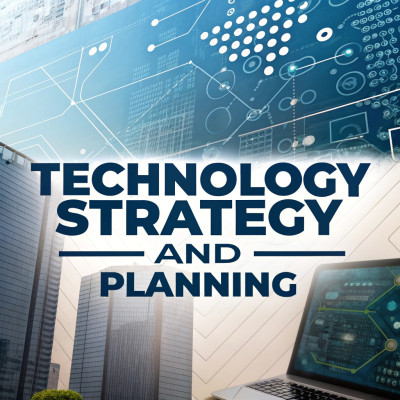Technology Strategy and Planning: Code, Create, Captivate
We have engineered several leading and secure apps that have allowed businesses to accelerate their growth and fully thrive. With us, you get cutting-edge development.
Get a Free Consultation
We Offer,
Technology Strategy and Planning

R
Utilized for data analysis and predictive modeling in chatbots.

Powershell
PowerShell is a task automation framework and scripting language developed by Microsoft, primarily used for managing and automating administrative tasks in Windows environments. It combines the power of a command-line shell with scripting capabilities, enabling users to automate complex system management tasks and access system APIs.

Microsoft Power Platform (PowerApps)
Microsoft Power Platform is a suite of applications, connectors, and a data platform that empowers users to build custom apps, automate workflows, and analyze data without extensive coding. PowerApps, a key component, allows users to create low-code applications for business needs.

Java
Java is a versatile, object-oriented programming language used for building platform-independent applications. Its robustness and scalability make it ideal for web, mobile, and enterprise-level software development.

Python
Dedicated assistance whenever you need it, ensuring a smooth and hassle

JavaScript
Our custom-built services are designed to meet your unique business requirements

SQL
SQL (Structured Query Language) is a domain-specific language used for managing and manipulating relational databases. It allows users to query, update, insert, and delete data, as well as manage database structures like tables and indexes.

Figma
Figma is a cloud-based design tool used for creating user interfaces, prototypes, and collaborative design work in real-time.
About This Service
Description of Technology Strategy and Planning
Technology Strategy and Planning is a vital part of modern business management, focusing on how an organization uses technology to meet its goals. It involves setting strategic directions, goals, and initiatives to align technology investments with business priorities, driving growth, innovation, and efficiency. Effective planning ensures technology systems and infrastructures are scalable, cost-effective, and prepared for the future, helping organizations remain competitive in a rapidly changing digital world.
Key Components of Technology Strategy and Planning:
-
Vision and Mission Alignment:
- The first step in technology strategy is to align technology initiatives with the organization’s vision, mission, and long-term goals. This involves understanding current business needs and future aspirations, and identifying how technology can support or enable business transformation.
-
Current Technology Assessment:
- A thorough evaluation of the current technology infrastructure is essential to identify strengths, weaknesses, gaps, and opportunities. This review covers hardware, software, cloud services, security, and data management systems. It helps organizations understand what works well and what needs upgrading or replacement..
-
Trend Analysis and Forecasting:
- Technology planners need to stay updated on emerging technologies and industry trends like AI, cloud computing, IoT, and blockchain. Understanding these innovations helps anticipate their impact—whether beneficial or disruptive—and supports informed decisions about technology investments and strategies.
-
Setting Strategic Goals and Objectives:
- Technology strategies should include clear, measurable goals that align with broader business objectives. This could involve improving operational efficiency, enhancing customer experience, adopting automation, enabling digital transformation, or increasing cybersecurity.
-
Technology Roadmap Development:
- The technology roadmap serves as a detailed plan that outlines the initiatives, projects, timelines, and resources required to achieve the strategic goals. It also defines the milestones and deadlines for various technology implementations. The roadmap provides clarity on the direction the organization is taking in terms of technology investments and growth.
-
Resource Allocation and Budgeting:
- Successful technology planning requires careful budgeting and resource allocation. It involves determining the financial, human, and technological resources required to execute the strategy. This could involve hiring new talent, investing in software, or procuring new hardware.
-
Risk Management and Mitigation:
- As technology adoption can come with risks, such as cybersecurity threats, integration challenges, and potential obsolescence, it is vital to identify, assess, and mitigate potential risks. This might involve implementing robust security protocols, adopting agile methodologies to minimize disruptions, or having contingency plans in place.

Our Process
Our experts create a full brief of your requirements and ideas. We translate these into technical documents and early-stage prototypes. We gather a team and build an initial design to lay the foundation for the entire project.

KICK-OFF STAGE
Leverage agile framework to provide a robust high level synopsys overviews

DEVELOPMENT STAGE
Bring to the table survival strategies to ensure proactive domination

SUPPORT STAGE
Grow the holistic world view of disruptive innovation workspace
Questions You May Have
We provide a range of IT consultancy services, including IT strategy development, infrastructure planning, cloud migration, cybersecurity solutions, and technology implementation guidance.
Yes, we offer IT project management services to ensure your technology projects are completed on time and within budget.
Our cloud migration approach includes assessment, planning, execution, and optimization to ensure a smooth transition with minimal downtime.
Yes, we conduct thorough audits of your IT infrastructure to identify areas for improvement and optimize performance.
Reach & Get in Touch With Us!
We'd love to hear from you. Please fill out the form below.
Got a Project ?




Stay Updated with the Latest News and Insights
Subscribe to our newsletter for exclusive updates, expert insights on innovative solutions, the latest tech trends, industry news, and special offers from TecishSol.




